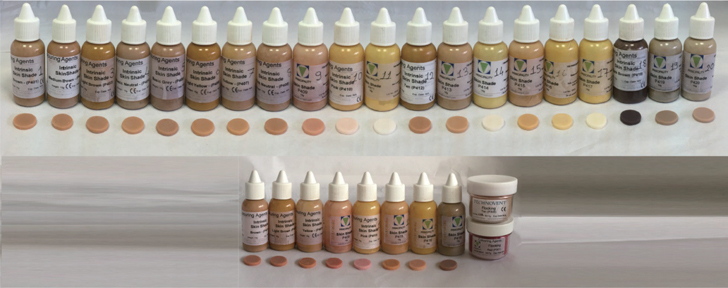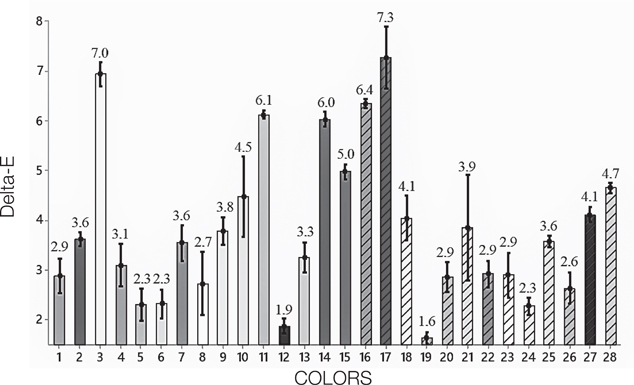J Adv Prosthodont.
2018 Dec;10(6):422-429. 10.4047/jap.2018.10.6.422.
In vitro evaluation of color and translucency reproduction of maxillofacial prostheses using a computerized system
- Affiliations
-
- 1Department of Prosthodontics, Faculty of Dentistry, Gazi University, Ankara, Turkey. secilkarakoca@yahoo.com
- 2Biostatistics and Medical Informatics Department, Faculty of Medicine, Ordu University, Ordu, Turkey.
- KMID: 2429375
- DOI: http://doi.org/10.4047/jap.2018.10.6.422
Abstract
- PURPOSE
Accurate color matching of maxillofacial prostheses to skin is important for esthetics. A computerized color matching system specific to human skin has recently been developed. The purpose of this study was to evaluate the accuracy in color and translucency matching of the computerized color matching system across different skin colors.
MATERIALS AND METHODS
The silicone was colored to simulate 28 different skin colors (n=5) to serve as "target skin colors". Using a spectrocolorometer (e-skin), color codes were determined for "replicate skin color" fabrication. CIELAB Delta-E between target skin color-replicate skin color pairs and translucency parameter were calculated. CIELAB Delta-E values were compared with one-way ANOVA and Tukey multiple-comparison. The agreement between L*, a*, b* and translucency parameter of target skin colors and replicate skin color were calculated by a two-way mixed average measures intraclass correlation coefficient. Translucency parameter of target skin color-replicate skin color pairs were compared with Paired t-test (α=.05).
RESULTS
The mean CIELAB Delta-E value was 3.83 and significant differences were found among colors. The intraclass correlation coefficient showed excellent reliability for L*, a*, b* and good reliability for translucency parameter (P < .001). The mean translucency parameter of replicate skin colors was significantly higher than that of translucency parameter.
CONCLUSION
The computerized color matching system specific to human skin was found to be reliable in terms of color and translucency between target skin colors and replicate skin color.
Keyword
MeSH Terms
Figure
Reference
-
1. Hickey AJ, Salter M. Prosthodontic and psychological factors in treating patients with congenital and craniofacial defects. J Prosthet Dent. 2006; 95:392–396.
Article2. Nemli SK, Aydin C, Yilmaz H, Bal BT, Arici YK. Quality of life of patients with implant-retained maxillofacial prostheses: a prospective and retrospective study. J Prosthet Dent. 2013; 109:44–52.
Article3. Andres CJ, Haug SP. Facial prosthesis fabrication: coloration techniques. In : Taylor TD, editor. Clinical maxillofacial prosthetics. Chicago IL: Quintessence Publishing Co, Inc;2000. p. 233–244.4. Hu X, Johnston WM. Translucency estimation for thick pigmented maxillofacial elastomer. J Dent. 2011; 39:e2–e8.
Article5. Hungerford E, Beatty MW, Marx DB, Simetich B, Wee AG. Coverage error of commercial skin pigments as compared to human facial skin tones. J Dent. 2013; 41:986–991.
Article6. Johnston WM, Ma T, Kienle BH. Translucency parameter of colorants for maxillofacial prostheses. Int J Prosthodont. 1995; 8:79–86.7. Coward TJ, Seelaus R, Li SY. Computerized color formulation for African-Canadian people requiring facial prostheses: a pilot study. J Prosthodont. 2008; 17:327–335.
Article8. Seelaus R, Coward TJ, Li S. Coloration of silicone prostheses: technology versus clinical perception. Is there a difference? Part 2, clinical evaluation of a pilot study. J Prosthodont. 2011; 20:67–73.
Article9. Xiao K, Zardawi F, van Noort R, Yates JM. Color reproduction for advanced manufacture of soft tissue prostheses. J Dent. 2013; 41:e15–e23.
Article10. Korfage A, Borsboomb PC, Dijkstra PU, van Oort RP. Analysis of translucency of skin by volume reflection for color formulation of facial prostheses. Int J Prosthodont. 2009; 22:623–629.11. Nuseir A, Hatamleh M, Watson J, Al-Wahadni AM, Alzoubi F, Murad M. Improved construction of auricular prosthesis by digital technologies. J Craniofac Surg. 2015; 26:e502–e505.
Article12. Kiat-amnuay S, Johnston DA, Powers JM, Jacob RF. Color stability of dry earth pigmented maxillofacial silicone A-2186 subjected to microwave energy exposure. J Prosthodont. 2005; 14:91–96.
Article13. CIE Technical Report. Colorimetry. 3rd ed. Publication 15. Vienna: CIE Central Bureau;2004.14. Cicchetti DV. Guidelines, criteria, and rules of thumb for evaluating normed and standardized assessment instruments in psychology. Psychol Assess. 1994; 6:284–290.
Article15. Paravina RD, Majkic G, Del Mar Perez M, Kiat-Amnuay S. Color difference thresholds of maxillofacial skin replications. J Prosthodont. 2009; 18:618–625.
Article16. Leow ME, Ow RK, Lee MH, Huak CY, Pho RW. Assessment of colour differences in silicone hand and digit prostheses: perceptible and acceptable thresholds for fair and dark skin shades. Prosthet Orthot Int. 2006; 30:5–16.17. Wee AG, Lindsey DT, Shroyer KM, Johnston WM. Use of a porcelain color discrimination test to evaluate color difference formulas. J Prosthet Dent. 2007; 98:101–109.
Article18. Douglas RD, Steinhauer TJ, Wee AG. Intraoral determination of the tolerance of dentists for perceptibility and acceptability of shade mismatch. J Prosthet Dent. 2007; 97:200–208.
Article19. Ragain JC Jr, Johnston WM. Minimum color differences for discriminating mismatch between composite and tooth color. J Esthet Restor Dent. 2001; 13:41–48.
Article20. Ruyter IE, Nilner K, Moller B. Color stability of dental composite resin materials for crown and bridge veneers. Dent Mater. 1987; 3:246–251.
Article21. Douglas RD, Brewer JD. Acceptability of shade differences in metal ceramic crowns. J Prosthet Dent. 1998; 79:254–260.
Article22. Melgosa M, Hita E, Perez MM, El Moraghi A. Sensitivity differences in chroma, hue, and lightness from several classical threshold datasets. Color Res Appl. 1995; 20:220–225.
Article23. Dawson JB, Barker DJ, Ellis DJ, Grassam E, Cotterill JA, Fisher GW, Feather JW. A theoretical and experimental study of light absorption and scattering by in vivo skin. Phys Med Biol. 1980; 25:695–709.
Article24. Ishikawa-Nagai S, Ishibashi K, Tsuruta O, Weber HP. Reproducibility of tooth color gradation using a computer color-matching technique applied to ceramic restorations. J Prosthet Dent. 2005; 93:129–137.
Article25. Xiao K, Zardawi F, Van Noort R, Yates JM. Developing a 3D colour image reproduction system for additive manufacturing of facial prostheses. Int J Adv Manuf Technol. 2014; 70:2043–2049.
Article26. Hatamleh MM, Watts DC. Porosity and color of maxillofacial silicone elastomer. J Prosthodont. 2011; 20:60–66.
Article
- Full Text Links
- Actions
-
Cited
- CITED
-
- Close
- Share
- Similar articles
-
- Criteria for clinical translucency evaluation of direct esthetic restorative materials
- Clinical Study of Maxillofacial Prostheses (Osseointegrated Implants for Maxillofacial Prostheses)
- Color stability of ceromers after thermocycling and brushing
- Comparison of the translucency of shaded zirconia all-ceramic systems
- Translucency changes of direct esthetic restorative materials after curing, aging and treatment




